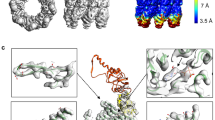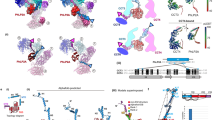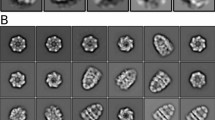Abstract
Group II chaperonins are essential mediators of cellular protein folding in eukaryotes and archaea. These oligomeric protein machines, ∼1 megadalton, consist of two back-to-back rings encompassing a central cavity that accommodates polypeptide substrates1,2,3. Chaperonin-mediated protein folding is critically dependent on the closure of a built-in lid4,5, which is triggered by ATP hydrolysis6. The structural rearrangements and molecular events leading to lid closure are still unknown. Here we report four single particle cryo-electron microscopy (cryo-EM) structures of Mm-cpn, an archaeal group II chaperonin5,7, in the nucleotide-free (open) and nucleotide-induced (closed) states. The 4.3 Å resolution of the closed conformation allowed building of the first ever atomic model directly from the single particle cryo-EM density map, in which we were able to visualize the nucleotide and more than 70% of the side chains. The model of the open conformation was obtained by using the deformable elastic network modelling with the 8 Å resolution open-state cryo-EM density restraints. Together, the open and closed structures show how local conformational changes triggered by ATP hydrolysis lead to an alteration of intersubunit contacts within and across the rings, ultimately causing a rocking motion that closes the ring. Our analyses show that there is an intricate and unforeseen set of interactions controlling allosteric communication and inter-ring signalling, driving the conformational cycle of group II chaperonins. Beyond this, we anticipate that our methodology of combining single particle cryo-EM and computational modelling will become a powerful tool in the determination of atomic details involved in the dynamic processes of macromolecular machines in solution.
This is a preview of subscription content, access via your institution
Access options
Subscribe to this journal
Receive 51 print issues and online access
$199.00 per year
only $3.90 per issue
Buy this article
- Purchase on Springer Link
- Instant access to full article PDF
Prices may be subject to local taxes which are calculated during checkout




Similar content being viewed by others
Accession codes
Primary accessions
Protein Data Bank
Data deposits
The three-dimensional cryo-EM density maps have been deposited into the EBI-MSD EMD database with accession codes: EMD-5137 (wild-type closed), EMD-5138 (lidless closed), EMD-5139 (wild-type open) and EMD-5140 (lidless open). The atomic models have been deposited in the Protein Data Bank as 3IYE (wild-type closed) and 3IYF (lidless open).
References
Bukau, B. & Horwich, A. L. The Hsp70 and Hsp60 chaperone machines. Cell 92, 351–366 (1998)
Frydman, J. Folding of newly translated proteins in vivo: the role of molecular chaperones. Annu. Rev. Biochem. 70, 603–647 (2001)
Hartl, F. U. & Hayer-Hartl, M. Molecular chaperones in the cytosol: from nascent chain to folded protein. Science 295, 1852–1858 (2002)
Ditzel, L. et al. Crystal structure of the thermosome, the archaeal chaperonin and homolog of CCT. Cell 93, 125–138 (1998)
Reissmann, S., Parnot, C., Booth, C. R., Chiu, W. & Frydman, J. Essential function of the built-in lid in the allosteric regulation of eukaryotic and archaeal chaperonins. Nature Struct. Mol. Biol. 14, 432–440 (2007)
Meyer, A. S. et al. Closing the folding chamber of the eukaryotic chaperonin requires the transition state of ATP hydrolysis. Cell 113, 369–381 (2003)
Kusmierczyk, A. R. & Martin, J. Nucleotide-dependent protein folding in the type II chaperonin from the mesophilic archaeon Methanococcus maripaludis. Biochem. J. 371, 669–673 (2003)
Dobson, C. M. Principles of protein folding, misfolding and aggregation. Semin. Cell Dev. Biol. 15, 3–16 (2004)
Balch, W. E., Morimoto, R. I., Dillin, A. & Kelly, J. W. Adapting proteostasis for disease intervention. Science 319, 916–919 (2008)
Yam, A. Y. et al. Defining the TRiC/CCT interactome links chaperonin function to stabilization of newly made proteins with complex topologies. Nature Struct. Mol. Biol. 15, 1255–1262 (2008)
Tam, S., Geller, R., Spiess, C. & Frydman, J. The chaperonin TRiC controls polyglutamine aggregation and toxicity through subunit-specific interactions. Nature Cell Biol. 8, 1155–1162 (2006)
Kitamura, A. et al. Cytosolic chaperonin prevents polyglutamine toxicity with altering the aggregation state. Nature Cell Biol. 8, 1163–1169 (2006)
Braig, K. et al. The crystal structure of the bacterial chaperonin GroEL at 2.8 Å. Nature 371, 578–586 (1994)
Saibil, H. R. et al. ATP induces large quaternary rearrangements in a cage-like chaperonin structure. Curr. Biol. 3, 265–273 (1993)
Booth, C. R. et al. Mechanism of lid closure in the eukaryotic chaperonin TRiC/CCT. Nature Struct. Mol. Biol. 15, 746–753 (2008)
Kusmierczyk, A. R. & Martin, J. Nested cooperativity and salt dependence of the ATPase activity of the archaeal chaperonin Mm-cpn. FEBS Lett. 547, 201–204 (2003)
Clare, D. K. et al. Multiple states of a nucleotide-bound group 2 chaperonin. Structure 16, 528–534 (2008)
Blow, D. Outline of Crystallography for Biologists (Oxford Univ. Press, 2002)
Ludtke, S. J. et al. De novo backbone trace of GroEL from single particle electron cryomicroscopy. Structure 16, 441–448 (2008)
Jiang, W. et al. Backbone structure of the infectious ε15 virus capsid revealed by electron cryomicroscopy. Nature 451, 1130–1134 (2008)
Zhang, X. et al. Near-atomic resolution using electron cryomicroscopy and single-particle reconstruction. Proc. Natl Acad. Sci. USA 105, 1867–1872 (2008)
Yu, X., Jin, L. & Zhou, Z. H. 3.88 Å structure of cytoplasmic polyhedrosis virus by cryo-electron microscopy. Nature 453, 415–419 (2008)
Braig, K., Adams, P. D. & Brünger, A. T. Conformational variability in the refined structure of the chaperonin GroEL at 2.8 Å resolution. Nature Struct. Biol. 2, 1083–1094 (1995)
Schoehn, G., Hayes, M., Cliff, M., Clarke, A. R. & Saibil, H. R. Domain rotations between open, closed and bullet-shaped forms of the thermosome, an archaeal chaperonin. J. Mol. Biol. 301, 323–332 (2000)
Schröder, G. F., Brunger, A. T. & Levitt, M. Combining efficient conformational sampling with a deformable elastic network model facilitates structure refinement at low resolution. Structure 15, 1630–1641 (2007)
Xu, Z., Horwich, A. L. & Sigler, P. B. The crystal structure of the asymmetric GroEL–GroES–(ADP)7 chaperonin complex. Nature 388, 741–750 (1997)
Boisvert, D. C., Wang, J., Otwinowski, Z., Horwich, A. L. & Sigler, P. B. The 2.4 Å crystal structure of the bacterial chaperonin GroEL complexed with ATPγS. Nature Struct. Biol. 3, 170–177 (1996)
Tang, Y. C. et al. Structural features of the GroEL-GroES nano-cage required for rapid folding of encapsulated protein. Cell 125, 903–914 (2006)
Suzuki, M. et al. Effect of the C-terminal truncation on the functional cycle of chaperonin GroEL: implication that the C-terminal region facilitates the transition from the folding-arrested to the folding-competent state. J. Biol. Chem. 283, 23931–23939 (2008)
Ludtke, S. J., Baldwin, P. R. & Chiu, W. EMAN: semiautomated software for high-resolution single-particle reconstructions. J. Struct. Biol. 128, 82–97 (1999)
Yang, C. et al. Estimating contrast transfer function and associated parameters by constrained nonlinear optimization. J. Microsc. 233, 391–403 (2009)
Ludtke, S. J., Jakana, J., Song, J.-L., Chuang, D. & Chiu, W. A 11.5 Å single particle reconstruction of GroEL using EMAN. J. Mol. Biol. 314, 253–262 (2001)
Harauz, G. & van Heel, M. Exact filters for general geometry three dimensional reconstruction. Optik 73, 146–156 (1986)
Fernández, J. J., Luque, D., Caston, J. R. & Carrascosa, J. L. Sharpening high resolution information in single particle electron cryomicroscopy. J. Struct. Biol. 164, 170–175 (2008)
Rosenthal, P. B. & Henderson, R. Optimal determination of particle orientation, absolute hand, and contrast loss in single-particle electron cryomicroscopy. J. Mol. Biol. 333, 721–745 (2003)
Pettersen, E. F. et al. UCSF Chimera—a visualization system for exploratory research and analysis. J. Comput. Chem. 25, 1605–1612 (2004)
Arnold, K., Bordoli, L., Kopp, J. & Schwede, T. The SWISS-MODEL workspace: a web-based environment for protein structure homology modelling. Bioinformatics 22, 195–201 (2006)
Emsley, P. & Cowtan, K. Coot: model-building tools for molecular graphics. Acta Crystallogr. D 60, 2126–2132 (2004)
Lovell, S. C. et al. Structure validation by Cα geometry: φ, ψ and Cβ deviation. Proteins 50, 437–450 (2003)
Acknowledgements
We acknowledge the support of grants from the National Institutes of Health through the Nanomedicine Development Center Roadmap Initiative, Biomedical Technology Research Center for Structural Biology in National Center for Research Resources, Nanobiology Training Fellowship administered by the Keck Center of the Gulf Coast Consortia and the National Science Foundation.
Author Contributions J.Z. and J.J. collected the cryo-EM image data. J.Z. performed the image processing and reconstructions with the assistance of C.J.F. M.L.B. did the modelling and analysis of the closed state. G.F.S. did the model fitting for the open state. N.R.D. and S.R. designed the lidless mutation, the biochemical conditions for the cryo-EM experiments and performed all biochemical characterizations and experiments. S.J.L. advised on data processing and map filtering. J.Z., N.R.D., M.L.B., G.F.S., J.F. and W.C. interpreted the structural results. M.D., W.C. and J.Z. prepared all the movies. All authors contributed to the preparation of the manuscript.
Author information
Authors and Affiliations
Corresponding authors
Supplementary information
Supplementary information
This file contains Supplementary Methods, Supplementary References and Supplementary Figures 1-6 with Legends. (PDF 615 kb)
Supplementary Movie 1
This movie shows 4.3 Å-resolution wild-type Mm-cpn cryo-EM density map in the closed state. (MP4 10638 kb)
Supplementary Movie 2
This movie shows backbone model for the wild-type Mm-cpn closed-state subunit. (MP4 4018 kb)
Supplementary Movie 3
This movie shows examples of visible sidechain densities in the wild-type closed state Mm-cpn cryo-EM density map. (MP4 10867 kb)
Supplementary Movie 4
This movie shows different degrees of flexibility in the wild-type and lidless Mm-cpn in open and closed conformations. (MOV 1311 kb)
Supplementary Movie 5
This movie shows simple geometric linear morphing between open and closed-state models of Mm-cpn to illustrate the spatial relationship of the two experimentally determined structures. This movie is not meant to represent the actual motion trajectory. (ZIP 19645 kb)
Rights and permissions
About this article
Cite this article
Zhang, J., Baker, M., Schröder, G. et al. Mechanism of folding chamber closure in a group II chaperonin. Nature 463, 379–383 (2010). https://doi.org/10.1038/nature08701
Received:
Accepted:
Issue Date:
DOI: https://doi.org/10.1038/nature08701
This article is cited by
-
Molecular chaperones and their denaturing effect on client proteins
Journal of Biomolecular NMR (2021)
-
Bridging human chaperonopathies and microbial chaperonins
Communications Biology (2019)
-
An information theoretic framework reveals a tunable allosteric network in group II chaperonins
Nature Structural & Molecular Biology (2017)
-
Structural and mechanistic characterization of an archaeal-like chaperonin from a thermophilic bacterium
Nature Communications (2017)
-
Structure of the human TRiC/CCT Subunit 5 associated with hereditary sensory neuropathy
Scientific Reports (2017)
Comments
By submitting a comment you agree to abide by our Terms and Community Guidelines. If you find something abusive or that does not comply with our terms or guidelines please flag it as inappropriate.



